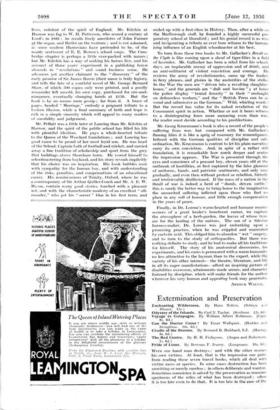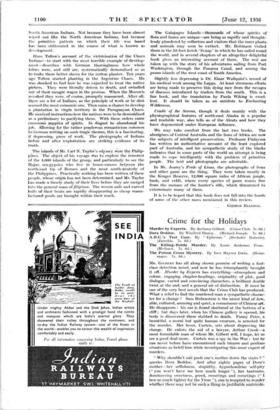Extermination and Preservation
Odyssey of the Islands. By Carl N. Taylor. (Scribner. 12s. 6d. Voyage to Galapagos. By William Albert Robinson. (Cape. 8s. 6d.) Can the Doctor Come By Einar Wallquist. (Hodder and Stoughton. 10s. 6d.) Cradle of the Storms. By Bernard B. Hubbard, S.J. (Harrap. 8s. 6d.) The Red Centre. By H. H. Finlayson. (Angus and Robertson. ,7s. 6d.) Pride of Lions. By Bertram F. Jearey. (Longman. 10s. 6(1.1 WITH one hand man destroys ; ' and with the other rescues his ..own ,. .own victims. At least, that is the impression one gain from reading these seven travel books, which all deal With victim races or species. In some cases destruction has been unwitting or merely careless ; in others deliberate and wanton. Sothetimes conscience is salved by the preservation as museum specimens of the relics of what has been destroyed ; often it is too late even to do that. It is too late in the case of the
South American Indians. Not because they have been almost wiped out like the North American Indians, but because the primitive pattern on which their life was based has been obliterated in the course of what is known as development.
Token's account of the victimisation of -Chaco Indian.--to start with the most horrible example of develop ment—describes with *German thoroughness how whole tribes were, and still are, systematically demoralised so as tOlnake them better slaves. for the cotton planter. Tenyears'. ago Totten started planting in the Argentine Chaco. He was shocked to find" WNW he was expected to treat the-native , pickers. They were- literally driven to death, and swindled- out of their meagre wages in the process. When the Mocowis revolted they were," of couise, promptly _massacred. After all,. there are a -lot of Indians, so the principle of work or be'_shOt seemed the most economic one. Then came a chance to develop a plantation in virgin territory in the Paraguayan Chaco. 'Ffe receivectinitructions how the.natives.were to be demOra' lised as-a- preliminary to pacifying them. With these orders came - enormods supplies of spirits.: In disgust he abandonell his job. AJloWing for the rather Ponderous romanticism common to:German writing on such tragic themes, this is a fascinating, if depressing, piece of work, are phofographs of Indians before Mid after exploitation are striking evidence of its
truth. _ . .
'The islands of Mr. Carl N. Taylor's odyssey were the Philip-
_
The -ohject, pf his voyage -seas to explore the remotest of the 4,800 islands of the group, and particularly to see the B,ajao. sea-gypsies who live, in house-canoes between the north-east tip of Borneo and the most south-westerly of the Philippines. Practically nothing has been written of these people, whose origin has not been determined, and Mr. Taylor has made a timely study of their Wei before they are merged into the general mass of filipinot. The woven sails and carved hulls of their boats are rapidly disappearing as cheap manu- factured goods are brought within their reach.
The Galapagos 'Islands= t ands of whose species of flora and fauna are unique—are being so rapidly and thought- lessly plundered by collectors and visitors that the rarer plants and animals may soon be extinct. Mr. Robinson visited them in the 32-foot ketch Sviiap ' in which he has sailed round the world, and in several chapters of an altogether delightful book gives an interesting account of them. The rest are taken up with the story of his adventures sailing from Port Washington, through the Panama Canal, and among the guano islands of the west coast of South America.
Slightly less depressing is Dr. Einar Wallquist's record of his medical work among the Lapps. At least strenuous efforts are being made to preserve this dying race from the ravages of diseases introduced by traders from the south. This is a fine book, and the translation by Paula Waking is excel- lent. It should be taken as an antidote to Enchanting Wilderness.
Cradle of the Storms, though it deals mainly with the physiographical features of north-east Alaska in a popular and readable way, also tells us of the Aleuts and how they have degenerated under European influence.
We may take comfort from the last two books. The aborigines of Central Australia and the lions of Africa are now the subjects of intelligent preservation. - Professor' Finlayson has written an authoritative account of the least explored part of Australia, and his sympathetic study of the blacks indicates that in some parts of the world an attempt is being made to cope intelligently with the problem of primitive people. The text and photographs are admirable.
In Mr. Jearey's Pride- of Lions, the photographs of lions and other game are the thing. They were taken mostly in the Kruger Reserve, 12,000 square miles of African jungle, bush, and veldt, where every species of game roams free from the menace of the hunter's rifle, which threatened to exterminate many of them.
It is to be hoped that this book does not fall into the hands of some of the other races mentioned in this review, G4ORGE ELLIDGE.























































 Previous page
Previous page